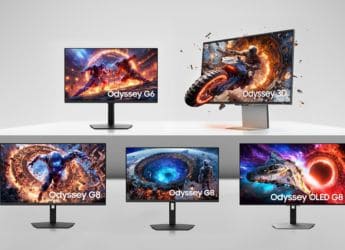- Home
- Laptops
- Laptops Reviews
- Lenovo Ideapad 510 Review
Lenovo Ideapad 510 Review

With Intel’s first series of 7th generation Core processors out in the wild, OEMs haven’t wasted any time in refreshing their products with these new chips. Lenovo recently unveiled its new range of products based on these 'Kaby Lake' CPUs, and today, we’ll be looking at the Ideapad 510.
This isn’t an entirely new product; it’s more of a refresh that’s aimed at mainstream multimedia users. The Ideapad 510 will face stiff competition from Dell’s Inspiron 15 5000 series and HP’s Pavilion 15 series, all of which have models with similar features as Lenovo’s, at around the same price point.
Let’s see if the Ideapad 510 can make a strong enough case for itself in this bustling segment.
Lenovo Ideapad 510 design and build
Being a mainstream laptop, the Ideapad 510 has a no-frills design and plastic body, for the most part. The lid and the keyboard area get sheets of metal for rigidity, but despite this, we found a fair bit of flex in the body even when applying moderate amounts of pressure. The plastic even creaks a bit when you press the joints, which indicates very average build quality. We’re also not too fond of the overall aesthetics, as the Ideapad 510 comes across as quite tacky for an upper mid-range laptop.
The 15.6-inch IPS display has a full-HD resolution, which is sharp enough for this size but not enough to require Windows scaling, so apps look and behave like they should. Lenovo does set the scaling to 125 percent by default to make things look bigger, but you can turn it off if you don't find the text too small. The panel’s colour temperature is a bit on the warmer side, which is easy on the eyes, but we wish there was a way to change this for those who prefer a more neutral tone.
![]()
The hinge of the display can be pushed all the way back, to 180 degrees. However, the torsion isn't good and there's an annoying wobble even with slight movements. This is particularly irritating if you're using this laptop on the move. There’s a good selection of ports spread out on both sides of the laptop. We have an SD card slot, a headphone and microphone combo jack, two USB 3.0 ports, one USB 2.0 port, HDMI and VGA outputs, LAN, and a DVD drive.
The Ideapad 510 features a full-sized keyboard with good spacing between the keys. There’s a single level of backlighting for the keys, which are evenly lit. Tactile feedback of the keys is good, but there is flex when typing. Our biggest gripe with the keyboard is the incorrect placement of the right Shift key, which is beyond the Up arrow. Naturally, you tend to press the wrong key nearly every time you type. The trackpad is also fairly large and is placed well so it doesn’t hinder typing. Its buttons don’t require too much effort to use but the trackpad itself feels a bit rough and unresponsive, especially for multi-finger gestures.
![]()
There are four rubber feet that provide ample elevation even on most uneven surfaces. This helps keep the vents on the bottom clear to take in cool air. The exhaust vents are placed on the inside of the hinge, away from you. The Ideapad 510 ships with a 65W power adapter, which looks like an oversized smartphone charger.
Lenovo Ideapad 510 specifications and features
The Ideapad 510 is available in a couple of different configurations and what we have here is the base model. You get an Intel Core i5-7200U, which is a dual-core CPU running at 2.5GHz. It has a maximum turbo frequency of 3.1GHz and supports HyperThreading. You also get 8GB of dual-channel DDR4 RAM, a 1TB hard drive, Wi-Fi 802.11ac, Bluetooth 4.1, and an HD webcam. The Ideapad 510 also has a dedicated Nvidia GeForce 940MX GPU with 4GB of dedicated RAM.
Lenovo gives you two quick-access slots underneath the laptop for the hard drive and RAM. Though there are two RAM modules, only one is user accessible.
![]()
The laptop ships with Windows 10 Home 64-bit and is accompanied by Lenovo’s software suite, which we’ve talked about before in detail in our Y700 gaming laptop review. Apart from this, you also get trial versions of Microsoft Office 365 and McAfee LiveSafe. You also get CyberLink’s Power2Go disc burning program. Overall, the Lenovo Ideapad 510 doesn't come with too much bloatware.
Lenovo Ideapad 510 performance
The Ideapad 510 manages day-to-day operations quite well. Booting is relatively quick, and the Core i5 CPU has no problem with a bit of multi-tasking. The laptop doesn’t heat up too much, but does get a little warm when charging it or when you're doing something intensive like gaming. You can feel the left side of the palm rest area and some of the keys getting warm. The bottom stays cool enough for you to use the Ideapad 510 comfortably on your lap. At full throttle, the exhaust fan is audible, but not loud enough to be a nuisance.
The display's viewing angles are pretty good, and the full-HD resolution makes creating and consuming content quite enjoyable. However, the maximum brightness level is a bit weak, even for indoor use, which means you’ll need to have it set to above 90 percent most of the time. The HD webcam captures good quality video, even with low ambient lighting indoors, and there’s a microphone array for audio capture.
In benchmarks, the laptop performs similarly to previous-generation Ultrabooks based on the sixth-generation Skylake Core i7-6700U CPU. Cinebench R15 gave us a score of 324 points in the CPU test and 48fps in the OpenGL graphics test. PCMark 8 returned 3199, 3569, and 2741 points in the Home, Creative, and Work test suites respectively. 3DMark put up a decent score of 1405 but that's still pretty weak when compared to laptops that use Nvidia’s GTX 950M, which are also available in this price range. We also have to point out that storage subsystem performance is quite average since the Ideapad 510 uses a standard 5400rpm mechanical hard drive.
![]()
You can get a bit of gaming done thanks to the dedicated GPU, provided you have reasonable expectations. We fired up Tomb Raider (2013), which gave us an average of 20fps at the native resolution and with the settings cranked up to High. However, actual gameplay was quite choppy at these settings so we had to dial down the resolution and some quality settings to Medium for the game to be enjoyable.
The Ideapad 510 is described as a ‘made for multimedia’ laptop and it does handle media playback well. We had no trouble running 4K videos, and the audio quality of the Harman speakers is quite good. The speakers are place on the bottom and fire downwards. The sound stage is decently wide with well-defined highs and mids. A presinstalled app lets you set equaliser settings for different media types (music, movies, gaming, chatting) and you can further boost the volume level from here too.
The 2-cell, 39WHr battery is non-removable, and lasted for just 1 hour and 51 minutes in Battery Eater Pro. With regular use, which included a bit of video, document creation and lots of Web surfing, we were able to stretch the Ideapad 510's battery life to three hours tops, which is still weak.
Verdict
Lenovo has priced the entry-level Ideapad 510 at Rs.60,890, which feels a bit too much considering the quality of the overall package. This laptop does fulfill its intended purpose, which is multimedia, as it offers a sharp display, very good speakers and a good webcam. We also like that it doesn’t get too hot, and that it is possible to upgrade the hard drive and RAM without much hassle.
There are a couple of things which Lenovo could have done to make this laptop a more compelling option. For starters, we would have liked better build quality, as the plastics used here don’t feel very durable. Even the fit and finish of the parts is rough. Other niggles include the low brightness level of the display, unresponsive trackpad, weird placement of the Shift key, and weak battery life.
Dell and HP have similarly powerful models for a bit more money although we haven’t tested their respective Kaby Lake refreshes yet. The Ideapad 510 might look better against them if its street price comes down a bit.
Price: Rs. 60,890
Pros
- Good audio performance
- Easy to upgrade the RAM and HDD
- Sharp display
- Decent system performance
Cons
- Average build quality
- Display brightness feels low
- Weird 'Shift' key placement
- Weak battery life
Ratings (Out of 5)
- Design: 2.5
- Display: 3.5
- Performance: 3.5
- Software: 4
- Value for Money: 3
- Overall: 3
Get your daily dose of tech news, reviews, and insights, in under 80 characters on Gadgets 360 Turbo. Connect with fellow tech lovers on our Forum. Follow us on X, Facebook, WhatsApp, Threads and Google News for instant updates. Catch all the action on our YouTube channel.
Related Stories
- Samsung Galaxy Unpacked 2025
- ChatGPT
- Redmi Note 14 Pro+
- iPhone 16
- Apple Vision Pro
- Oneplus 12
- OnePlus Nord CE 3 Lite 5G
- iPhone 13
- Xiaomi 14 Pro
- Oppo Find N3
- Tecno Spark Go (2023)
- Realme V30
- Best Phones Under 25000
- Samsung Galaxy S24 Series
- Cryptocurrency
- iQoo 12
- Samsung Galaxy S24 Ultra
- Giottus
- Samsung Galaxy Z Flip 5
- Apple 'Scary Fast'
- Housefull 5
- GoPro Hero 12 Black Review
- Invincible Season 2
- JioGlass
- HD Ready TV
- Laptop Under 50000
- Smartwatch Under 10000
- Latest Mobile Phones
- Compare Phones
- Huawei Nova 15
- Huawei Nova 15 Pro
- Huawei Nova 15 Ultra
- OnePlus 15R
- Realme Narzo 90x 5G
- Realme Narzo 90 5G
- Vivo S50 Pro Mini
- Vivo S50
- Asus ProArt P16
- MacBook Pro 14-inch (M5, 2025)
- Huawei MatePad 11.5 (2026)
- OnePlus Pad Go 2 (5G)
- OnePlus Watch Lite
- Just Corseca Skywatch Pro
- Acerpure Nitro Z Series 100-inch QLED TV
- Samsung 43 Inch LED Ultra HD (4K) Smart TV (UA43UE81AFULXL)
- Asus ROG Ally
- Nintendo Switch Lite
- Haier 1.6 Ton 5 Star Inverter Split AC (HSU19G-MZAID5BN-INV)
- Haier 1.6 Ton 5 Star Inverter Split AC (HSU19G-MZAIM5BN-INV)
-
 Fact Check: Is Microsoft Really Planning to Rewrite Windows 11 in Rust Using AI?
Fact Check: Is Microsoft Really Planning to Rewrite Windows 11 in Rust Using AI?
-
 Oppo K15 Turbo Pro Tipped to Launch With New MediaTek Dimensity 9500s Chip
Oppo K15 Turbo Pro Tipped to Launch With New MediaTek Dimensity 9500s Chip
-
 Samsung 6K 3D Odyssey G9, Four Other Monitors Unveiled Ahead of CES 2026
Samsung 6K 3D Odyssey G9, Four Other Monitors Unveiled Ahead of CES 2026
-
 Crypto Markets Stay Range-Bound, Traders Wary as Liquidity Remains Thin
Crypto Markets Stay Range-Bound, Traders Wary as Liquidity Remains Thin










